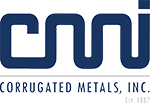Why should I consider roll forming my parts?
Roll forming offers many benefits including its strict consistent adherence to close tolerances. This allows Corrugated Metals, Inc. to provide the shapes or profile you need consistently each order. It is possible to eliminate many typical secondary operations by using the roll forming process reducing end-user costs. It is especially well suited to long continuous run projects. The cut to length option roll forming offers helps reduce scrap costs and material storage needs. However, the major advantage of roll forming is the increase in strength to weight ratio over plain sheet metal. This strength allows some shapes to be produced with thinner walls than competing processes, reducing material costs.

